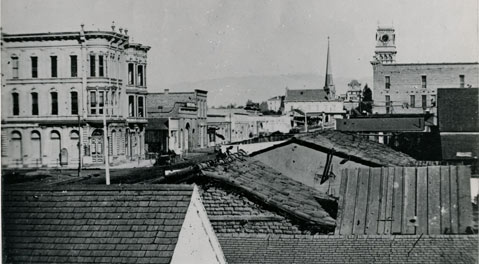Early Banks and Banking in Santa Barbara

Mortimer Cook opened this city’s first bank on October 6, 1871. Before this, almost all financial transactions were handled in cash, with Santa Barbarans acting as their own bankers.
In the first half of the 19th century, silver, gold, even cattle hides were all media of exchange. By the 1860s, American currency was becoming more common. By and large, people kept their money in their home. The county treasurer would hold large sums for people, and visitors could count on the Wells Fargo office for safekeeping of their funds and other valuables. As the city moved into the 1870s, however, it was still without a true bank.

Mortimer Cook came to Santa Barbara in 1871, bringing with him the only iron safe in town. The first newspaper advertisement for his private bank stated, “Mortimer Cook, banker, capital stock $40,000. I am prepared to do all and every business in my line. Buy and sell greenbacks [paper money] … Receive deposits and do all other business connected with general banking business. Hours from 9 am to 3 pm.”
In 1873, he founded the First National Gold Bank of Santa Barbara with himself as president at a salary of $1,200. The new bank’s cashier was A. L. Lincoln, builder of what is today the Upham Hotel. Bank advertisements offered time certificates at a monthly interest rate of one and one-half percent.
In 1874, the bank moved to the northwest corner of Canon Perdido and State streets. The bank did well until a serious drought in 1877 caused financial panic. A run on the bank appeared imminent. W. W. Hollister, the bank’s vice-president and one of the city’s outstanding entrepreneurs, averted disaster by placing himself at the bank’s doors and personally guaranteed the holdings of worried depositors.
Still, the bank was badly hurt, and Cook lost most of his personal fortune. He had been very active in the community, twice serving as mayor. His office building at State and Carrillo streets with its large clock tower was a downtown monument until its destruction in the 1925 earthquake. His home, which still stands at 1407 Chapala Street, is an outstanding example of the Italianate style of Victorian architecture and is a City of Santa Barbara Historical Landmark.
The second bank to open here was Santa Barbara County Bank, founded by William Eddy in 1875. Eddy had come to Santa Barbara after trying his luck in the silverfields of Nevada. On the board of directors was John Edwards, whose three sons would go on to become presidents of banks in Santa Barbara. Although the city’s population stood at only around 3,000 at this time, it was still one of the fastest-growing in the state, and by 1880, the bank had become a solid success.
Santa Barbara’s third bank was born in the autumn of 1886. Santa Barbara Savings Bank was formed in the excitement of the knowledge that the Southern Pacific Railroad would soon reach the city. The bank officially opened under a new name, the Commercial Bank, just two days before the much anticipated arrival of the railroad in August 1887.
By the mid-1880s, the father of it all, Mortimer Cook, had moved on to the Washington Territory and then the Philippines, making fortunes, losing them, and then making them all over again. He died in the Philippines in 1899 a wealthy man, having made his final fortune in the lumber business.



